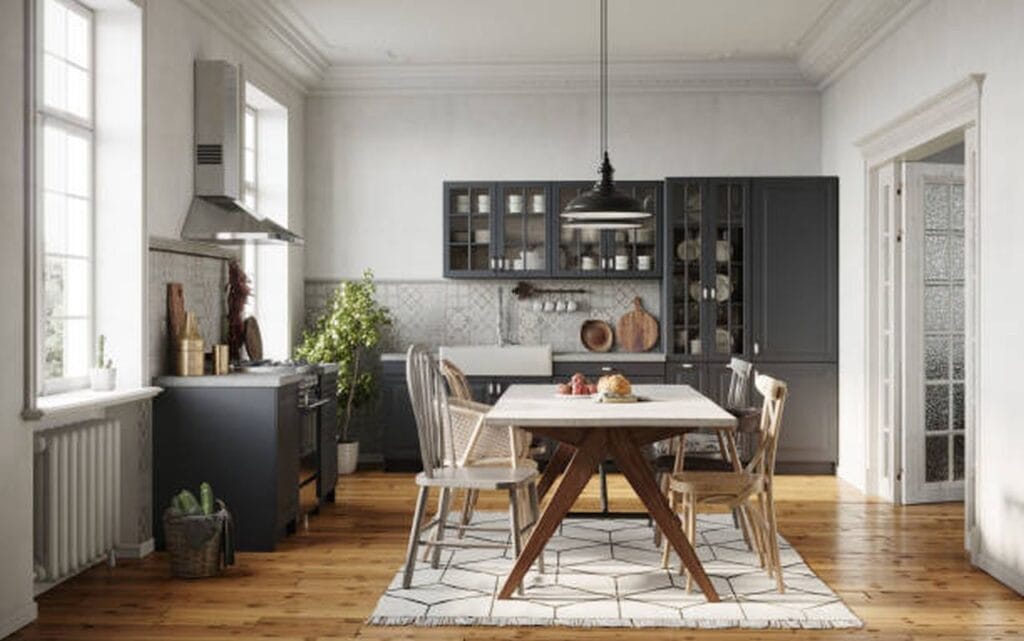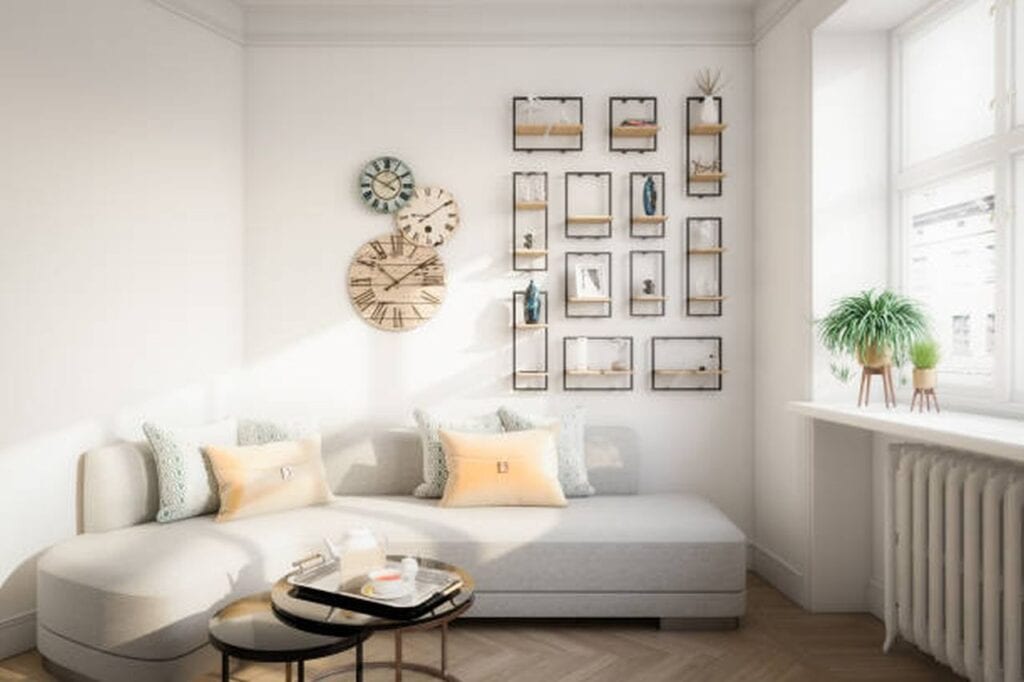Decorating a small area can make you feel like you're squished, but there are actually several advantages to working with a limited amount of square footage. Inexpensively expanding a cramped space with these tried-and-true methods.
Scale It Down
The key to furnishing a cramped apartment is to think in terms of scale. Let's say something touches the top or bottom or side of the room. Then, to make a space feel more open, avoid pushing furniture up against the walls. (A bed is the one exception; sandwiching a queen between two walls, for example, results in a cosy sleeping cave.)
Also, stay away from bulky furniture that takes up too much area. Sleek sofas and chairs, for instance, offer the same amount of seating space as their oversized counterparts but take up much less room. Whether it's a painting, a mirror, or something else entirely, a huge wall hanging can make a bold statement in any room. If you want to avoid taking up precious floor space, store it somewhere else.
Maintain A Low Profile
Simply by leaving more headroom above them, lower furniture can make a room feel more spacious. Consider putting a mattress on the floor or opting for a loft bed. Low, mid century furniture in the living room is a great way to channel your inner Mad Men. Or if you prefer something more romantic and beautiful, 19th century furniture is also very discreet.
Present Some Leg With Light Furniture.
Once again, the key to making a small room feel larger is to emphasise transparency and fluidity. Sleek furniture lets air and light pass freely over, beneath, and all around it, giving the illusion that it is floating in the room. Low and slender, as in the furniture of the mid-century modern era. The butterfly chair is another example of soaring furniture.
Get Rid Of Your Drapes And Rugs
We learned this the hard way with mirrors: it's all about fooling the sight. Even if they don't completely block the window, curtains nonetheless prevent the outside world from being seen. Curtains and drapes also increase the amount of "stuff" in a room. Getting rid of them simplifies the area. Shutters, or perhaps some flimsy shades made of mesh or cloth, can provide the necessary seclusion. Alternatively, you might remove the curtains altogether by installing a long bar that extends well beyond the window frame.
Rugs are a case in point. Read this essay carefully, paying close attention to the fine details. Not many people use rugs, and the ones who do tend to be very basic in design.
White It Out
White's reflecting properties are common knowledge. It brightens up the space, making it feel more open and peaceful. The cloud-like effect is accentuated by the walls being painted and ceilings the same white. And it helps to trick the eye into thinking the ceiling is higher than it actually is by dissolving the distinction between wall and ceiling. Last but not least, white is an excellent option in compact rooms that are prone to visual chaos due to its ability to both simplify the design and highlight the room's architecture.
If you're afraid that an all-white room would be too chilly, add some wood or texture, like a plush wool throw. Keep in mind that you can go with any colour you like and not only white.
Emphasise The Vertical
Adding even one feature—a tall shelf, some shiplap running vertically, or even just a naked hanging bulb like the one in the bedroom up top—that draws attention upwards will help the area feel airier and more expansive. Additionally, it improves the sense of motion and fluidity.
Emphasise The Horizontal
The key is to make anything feel like it's moving. Anything that directs the eye around a room in a planned and organised fashion, such as the tall, slim legs of dynamic furniture or the reflective surfaces of mirrors, produces the illusion of more space. We use the phrase "international and orderly" since it is also possible for your eyes to wander aimlessly in a chaotic environment.
Clear A Pathway
When working with limited square footage, it's human nature to want to force everything to the room's perimeter. However, this might heighten claustrophobia if it causes you to constantly bump into things. It's helpful to have clear pathways, therefore it's sometimes best to stack furniture against one wall.
Use Breezy Fabrics
Light should be allowed to freely move about the area, therefore avoid using dark materials and fabrics. For instance, if you want to make a room feel more open and airier, linen is a great choice because it is both lightweight and durable.
Could You, Above All, Keep It Simple?
Space constraints force one to be selective. A room will feel more cluttered as you add additional furniture, personal items, and decorative themes to it. Keep the number of trinkets to a minimum or exhibit them in a way that makes them seem like an installation. The same goes for artwork; select one or two walls to decorate exclusively with framed displays. Keep away from loud colour schemes and patterns. If you really can't resist the wallpaper, maybe just use it to decorate one wall. The same holds true for colour; experiment with painting only one wall or door with a single hue. This is not the moment to welcome everyone and everything.
The takeaway is that you should be strict with yourself (and, really, this idea is applicable to any place) and choose each addition to the room carefully. Keep the remainder of the space uncluttered if you choose to use wallpaper as an accent wall. Don't hang a bunch of other paintings or photos on the walls if you absolutely must have that massive oil painting in the living room.
Get The Floor And Walls Cleaned Up
It also includes the empty areas between pieces of furniture and the walls. The area looks even smaller when all the furniture is pushed up against the walls to reveal just how little actual floor space there is. In addition, you may make a room feel more spacious by placing some of your furnishings away from the wall.
Store Smartly
Try some new organisational strategies and be more discerning about what you keep out. You may keep things simple by doing things like storing blankets folded up in a chest or basket, keeping pet toys in a separate basket, and hanging pictures rather than setting them on tables or nightstands.
Furniture that can serve as both a seat and a place to store things is a terrific way to make the most of the room you have. Storage-friendly seating, coffee tables, and ottomans are just a few examples of how to keep the living room neat and free of blankets, movies, games, and other knick knacks. Floating shelves are a great way to keep clutter off the floor while also adding visual length to your walls.

Install Only One Type Of Flooring
You can make a house look more spacious and put forth a unified design aesthetic by installing the same flooring in every room.
Keep Pathways Open
If you want to be able to move around the room freely and see clearly, you should avoid pushing furniture up against the walls. To add to the effect, clearing the area in between and around pieces of furniture is a great way to make the room feel more open.
Focus On Reflection
A room can look larger thanks to mirrors since they reflect the light as well as the view outside. Places near entrances, at the end of corridors, and opposite windows tend to be well-visited.
Bedroom interior design detail showing the use of reflective surfaces and bright colours to create the illusion of more space.
Mirrors can increase the sense of space in a room by reflecting light.
Shine A Light
Putting in more lighting is a simple technique to increase the sense of space and light in a confined area. The directional light and minimal footprint of recessed lighting make it a popular option.
Go Vertical
Create the illusion of height with vertical elements like floor lamps, shiplap (wood planks), or floating shelving. Leeds also suggests hanging your drapes on rods that are taller and broader than usual, suggesting that you hang them two or three inches below the ceiling and six or eight inches outside the side trim.
Use Built-Ins
Murphy beds and bookcases that fold up into the wall provide a space-saving sleeping and working solution for compact living quarters.
Scale Down
You should stay away from dark, heavy furniture as it tends to make a space look even smaller. Bolden argues that exposing the legs of your furniture helps to generate a feeling of freedom and movement.
Use Lucite And Glass
Using see-through materials makes the area beyond seem further away. Clear, frameless glass shower enclosures, for instance, can make a big difference in a small bathroom by replacing an opaque one. Though the space is unaltered, it will give the impression of being larger. Even though it's only an extra three feet, being able to see all the way to the rear wall of the shower makes a huge impact. Table tops can also be made out of glass or lucite. A table with a stone, metal, or wooden foundation will free up the area surrounding it, allowing you to take in the scenery.
Include Reflective Surfaces
You can hang a huge framed mirror on the wall, or prop a huge framed mirror up against the wall. This is similar to the effect a mirrored wall would have on a smaller space, but it adds a touch of class to any decor. The reflective surface will make the space seem larger and brighter. Put a mirror on top of a coffee table, side table, or even a chest of drawers to make a statement.
Go Big
Make a tiny room look less cluttered by using a few large, uncomplicated furniture pieces or accessories. Incorporating more white space and larger blocks of colour can make a space feel more relaxing and inviting.
Retain The Upholstery Simple.
Instead of going wild with plaids, stripes, or designs, opt for upholstery in basic colours. Keep colour palettes simple and add visual interest with textures.
Use Only Light, Airy Fabrics.
Light can easily flow through sheer curtain panels, bed skirts, and tablecloths. Find delicate flowery vines or basic stripes if you must have patterns instead of solid colours.
Make Sure The Flow Of Your Furniture.
The same amount of furniture can make a space feel open and spacious or closed in and claustrophobic, depending on how it is arranged. Avoid blocking traffic by putting bulky furniture in the middle of the room. You should also provide enough room for people to walk around the room and avoid having furniture in the way of doors and windows.
Hang Your Curtains High
There is no hard and fast rule that states the curtain rod must be hung directly over the window. Rather, hang the rod 4 to 6 inches above the window frame and complete the appearance with floor-length curtains to make a tiny space seem taller.
Bring In The Light
There's a good reason why realtors insist their clients keep the lights on during showings. The effect of darkness is to make a room feel not only unwelcoming but also smaller. To increase the amount of light in a room, you should replace heavy drapes with light, transparent ones, install higher-wattage warm-colored LED bulbs, and set up lamps, string lights, etc.
Create Space For Storage
Having your home's shelving and cabinets installed by professionals is the most organised and streamlined option. Due to the added height and texture, they also do a great job of making a room feel more expansive. If you're handy with a drill, they're also not as pricey as you might imagine.
Or Hide Your Storage All Together
Obtaining pieces of furniture that also serve as storage units is a great way to declutter and free up a room. When it comes to optimising the space in your home, you can get more for your money by purchasing a coffee table, bench, or ottoman that has concealed storage space inside.
Raise The Cabinets In Your Kitchen
This one is a bit on the pricier side, but it's OK. But if you're doing a minimal kitchen redesign, you can raise your cabinets to make the room feel taller. One of the simplest methods to create a noticeable difference and give the illusion of more space in your kitchen is to raise the cabinets. This may be done by replacing them with taller ones, raising the floor, or adding crown moulding to the tops.
Select The Correct Rug Size
Rugs are not only practical in terms of foot comfort, but also visually significant in creating a room's overall scale. Use carpets strategically to provide the illusion of extra area in a room. Choose one large area rug over several smaller rugs and give them roughly a foot of breathing distance from the walls.

Put Up Some Mirrors
Mirrors, like windows, can visually expand a space. Reflections make a room seem twice as big because they transform a two-dimensional surface into a three-dimensional volume. Putting up a mirror opposite a window can help bring in additional light if there isn't enough coming in through the window itself.
Keep Furniture Off The Floor
It's as though large furniture, such as sofas and chests of drawers, are more weighty when they're lifted off the floor. Instead, use pieces of furniture that rest on legs to create a visual break and more usable floor space.
Paint With Light Colours And Some Smart Pops Of Colours
A fresh coat of paint may do wonders for giving the illusion of more space. If you want to make a room seem bigger, lighter colours like white, light grey, beige, light blue, etc. are your best bet. It doesn't mean, though, that you can't play around with colour! If you want to use a brilliant colour without making the room feel too confining, try an accent wall rather than painting the whole thing, or try a colour block in which two-thirds of the wall's vertical space is painted a vivid colour and one-third is painted a light neutral.
The key to making a space feel larger is to strike a balance between the room's light and dark elements, its weight and airiness, and its vertical and horizontal dimensions. You can make a room seem larger by making better use of the available floor space and by raising the height of the ceiling. The end result is a home that appears much larger than it is, and the most efficient use of available space. But if you ever feel like you need more room, keep in mind that bigger residences aren't necessarily better.
Conclusion
Achieving the optical illusion of a larger room can be as simple as selecting the appropriate paint colours, installing mirrors and lights, and experimenting with furniture placement and scale. If you want your guests to feel at home and relaxed, try using some of these tricks from the pros to make your home look bigger than it actually is.
FAQs About Builders
- Make sure you have enough natural lighting.
- Use raised sofas and armchairs.
- Go for wall-to-wall bookcases.
- Include mirrors.
- Paint your ceiling with a bright colour.
- Hang Artwork.
- Space It Out.
Thin stripes give the appearance of stretching; vertical stripes will make a room appear taller and horizontal stripes will make a room look wider. Consider applying striped wallpaper to not only create an illusion of more space but to create a simplistic feature wall.
Installing wallpapers with very small patterns will make the room look bigger with so much activity. On the other hand, larger designs create the illusion that there’s not much space for imprints and thus give off the feeling of a smaller room.
Rugs or carpets can also help you create the illusion of a larger room. Large area rugs (avoid placing several small rugs) can make your place look more prominent. They should be within 12 inches of the walls on all sides.
According to basic design principles, light colours such as white, crème, pastel blue, grey or yellow will visually expand a room, while dark colours such as a deep red, green or brown will make a room feel smaller.

